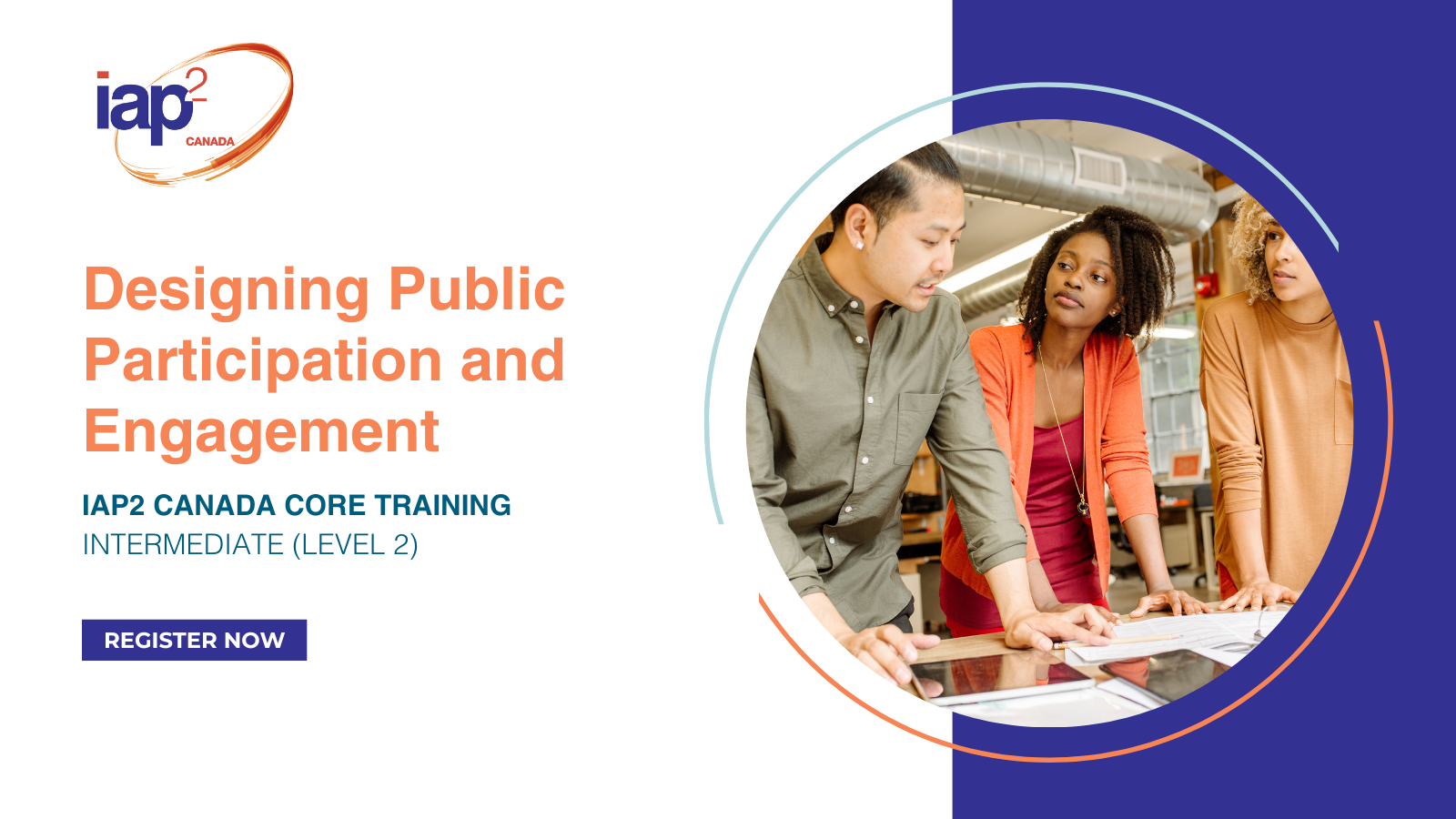 Either "Fundamentals of Public Participation and Engagement (Level 1 practitioners)" or "IAP2 Way in Challenging Contexts (Level 2 practitioners)" is a prerequisite for this course. Learn more
Either "Fundamentals of Public Participation and Engagement (Level 1 practitioners)" or "IAP2 Way in Challenging Contexts (Level 2 practitioners)" is a prerequisite for this course. Learn more
Designing & Leading Engagement is a Level 2 course that introduces practitioners to the design and plan phases of the practice framework, providing them with the opportunity to develop public participation and engagement practice plans. This includes scoping, community mapping, determining purpose and objectives and levels of influence, choosing appropriate methods and managing resources, while considering the needs of diverse audiences.
Register Now!
Course Objectives:
By the end of this course, participants will be able to design an engagement process and plan for a real-world scenario, including:
- Plan a clear scope of the work, problem or opportunity with identified negotiables and non-negotiables
- Conduct detailed stakeholder analysis, community mapping and equity analysis
- Identify appropriate roles and levels of influence for key players
- Establish clear engagement purpose and objectives and success criteria/measures to suit the scenario
- Identify relevant profiles of engagement
- Conduct a detailed risk/opportunities analysis
- Choose and sequence appropriate methods (in-person and digital) and identify communication tactics to suit the scenario
- Identify key roles for senior leaders and decision makers
- Explore principles and approaches for equity, diversity and inclusion and apply them to stakeholder analysis
- Embed digital strategies, platforms, and methods as part of the plan and process
- Develop an evaluation framework to suit the scenario
- Identify key roles and resources needed to implement the P2/engagement plan
- Develop and apply a suitable pitch to senior leaders that will secure commitment and resources for the P2/engagement plan
- Identify the many different contexts of engagement including the elements present in more complex engagement scenarios
Target Audience:
- Practitioners who are leading the planning and implementation of public participation and engagement practice processes
- Participants who will be involved in the design and planning of public participation and engagement practice processes
Course Delivery:
This course is delivered in-person in Winnipeg, MB . This is an IAP2 Canada core training course delivered externally by a IAP2 licensed trainer.
Prerequisite:
Either "Fundamentals of Public Participation and Engagement (Level 1 practitioners)" or "IAP2 Way in Challenging Contexts (Level 2 practitioners)" is a prerequisite for this course.
Learn more
Cost:
$875.00 + applicable tax
Our Trainers:
 Kim Hyshka, CP3 is a believer that just about anything is possible with a little dialogue. She’s on a mission, to chart a different course for public conversations, better conversations that open possibility, cultivate collaboration and spark change through dialogue. With over 10 years working in the field of engagement, she has developed a passion for designing and facilitating conversations that matter and creating engagement experiences where participants feel valued, relationships are built and initiatives and projects move forward. You’ll find her in the midst of both large and small-scale projects, bringing experience facilitating community forums in large urban centers or walking pipelines with Elders in the remote wilderness.
Kim Hyshka, CP3 is a believer that just about anything is possible with a little dialogue. She’s on a mission, to chart a different course for public conversations, better conversations that open possibility, cultivate collaboration and spark change through dialogue. With over 10 years working in the field of engagement, she has developed a passion for designing and facilitating conversations that matter and creating engagement experiences where participants feel valued, relationships are built and initiatives and projects move forward. You’ll find her in the midst of both large and small-scale projects, bringing experience facilitating community forums in large urban centers or walking pipelines with Elders in the remote wilderness.
 Tannis Topolnisky, CP3 over 20 years of public engagement experience and has been a licensed trainer of the IAP2 Foundations and IAP2 for Decision Makers courses since 2011. She has worked in a variety of areas such as legislation, policy and program development, health, contaminated sites, heritage conservation, municipal budgeting, land use planning, affordable housing, education and more. Tannis has diverse experience engaging communities, interest groups, non-government organizations, professional and industry associations, academics, patient groups and Indigenous peoples. She often finds herself planning and facilitating projects where there are potential impacts to health, livelihood, relationships, community and quality of life.
Tannis Topolnisky, CP3 over 20 years of public engagement experience and has been a licensed trainer of the IAP2 Foundations and IAP2 for Decision Makers courses since 2011. She has worked in a variety of areas such as legislation, policy and program development, health, contaminated sites, heritage conservation, municipal budgeting, land use planning, affordable housing, education and more. Tannis has diverse experience engaging communities, interest groups, non-government organizations, professional and industry associations, academics, patient groups and Indigenous peoples. She often finds herself planning and facilitating projects where there are potential impacts to health, livelihood, relationships, community and quality of life.
